The Ussher chronology is a 17th-century chronology of the history of the world formulated from a literal reading of the Old Testament by James Ussher, the Archbishop of Armagh and Primate of All Ireland. The chronology is sometimes associated with young Earth creationism, which holds that the universe was created only a few millennia ago by God as described in the first two chapters of the biblical book of Genesis. Ussher's work fell into disrepute in the 19th century.
Published in 1650, the full title of Ussher's work in Latin is Annales Veteris Testamenti, a prima mundi origine deducti, una cum rerum Asiaticarum et Aegyptiacarum chronico, a temporis historici principio usque ad Maccabaicorum initia producto ('Annals of the Old Testament, deduced from the first origins of the world, the chronicle of Asiatic and Egyptian matters together produced from the beginning of historical time up to the beginnings of Maccabees').
Ussher's work was his contribution to the long-running theological debate on the age of the Earth. This was a major concern of many Christian scholars over the centuries.
The chronology is sometimes called the Ussher–Lightfoot chronology because John Lightfoot published a similar chronology in 1642–1644. This, however, is a misnomer, as the chronology is based on Ussher's work alone and not that of Lightfoot. Ussher deduced that the first day of creation was October 22, 4004 BC on the proleptic Julian calendar, near the autumnal equinox. Lightfoot similarly deduced that Creation began at nightfall near the autumnal equinox, but in the year 3929 BC.
Ussher's proposed date of 4004 BC differed little from other biblically based estimates, such as those of Jose ben Halafta (3761 BC), Bede (3952 BC), Ussher's near-contemporary Scaliger (3949 BC), Johannes Kepler (3992 BC), and Isaac Newton (c. 4000 BC).[1] [dubious – discuss] Ussher was influenced by the same account as the apocryphal Book of Jasher,[dubious – discuss] dating the worldwide flood to 2349 BC and the birth of Terah in 2127 BC. The date of 4000 BC as the creation of Adam was at least partially influenced by the widely held belief that the Earth was approximately 5600 years old (2000 from Adam to Abraham, 2000 from Abraham to the birth of Christ, and 1600 years from Christ to Ussher), corresponding to the six days of Creation, on the grounds that "one day is with the Lord as a thousand years, and a thousand years as one day" (2 Peter 3:8). This tradition was believed to indicate that Jesus would return in AD 2000,[2][3] more than six thousand years after 4004 BC. Modern proponents of this interpretation hold that the creation date 4004 BC could be inaccurate.
- ^ William W. Hay (2012). Experimenting on a Small Planet: A Scholarly Entertainment. Springer. p. 63. ISBN 9783642285608. Retrieved November 17, 2013.
- ^ Kenneth G. C. Newport (28 August 2000). Apocalypse and Millennium: Studies in Biblical Eisegesis. Cambridge University Press. p. 104. ISBN 978-0-521-77334-8. Retrieved 23 March 2011.
- ^ Christopher Rowland; John Barton (2002). Apocalyptic in history and tradition. Sheffield Academic Press. pp. 233–252. ISBN 978-0-8264-6208-4. Retrieved 23 March 2011.



